Looking to elevate your garden with a touch of elegance and vertical beauty? Clematis vines are a gardener’s favorite thanks to their vibrant blooms and enthusiastic climbing habit—making them ideal for a wide range of clematis trellis ideas that add both structure and charm to your outdoor space. From rustic to modern, artistic to DIY, the right trellis can transform your clematis into a living masterpiece.
In this guide, we’ll walk you through 20 inspiring clematis trellis ideas designed to bring your garden to life. Whether you dream of a whimsical bamboo teepee or a sleek gabion cage, these carefully curated ideas blend beauty and function. And if you’re looking for even more creative support structures, don’t miss our 10 innovative DIY garden trellis ideas that pair beautifully with clematis and other climbing plants. No matter the size of your space—be it a sprawling backyard or a cozy patio—you’ll find plenty of inspiration to help your clematis climb with style.
Table of Contents
1. Bamboo Teepee – A Natural Touch in Clematis Trellis Ideas
For gardeners exploring clematis trellis ideas with a natural and whimsical flair, the bamboo teepee is a standout choice. Crafted by lashing bamboo poles into a conical shape, it provides a lightweight, rustic framework perfect for clematis vines. It’s one of the most charming options for DIY garden trellis projects, especially in cottage-style gardens where organic materials enhance the overall vibe.
Among the most charming clematis trellis ideas for cottage-style or relaxed outdoor spaces, the bamboo teepee combines form and function effortlessly. Bamboo is lightweight, sustainable, and easy to assemble—making it a favorite DIY solution for gardeners seeking an eco-friendly and rustic vertical support.
Why it works for clematis:
- The open frame allows excellent air circulation.
- Bamboo’s natural surface provides great grip for vine tendrils.
- Adds vertical interest without overwhelming the space.
Tips:
- Use at least six bamboo poles for balance and stability.
- Secure joints with natural twine or weather-resistant rope.
- Position in full to partial sun for optimal clematis growth.
2. Bamboo Arch
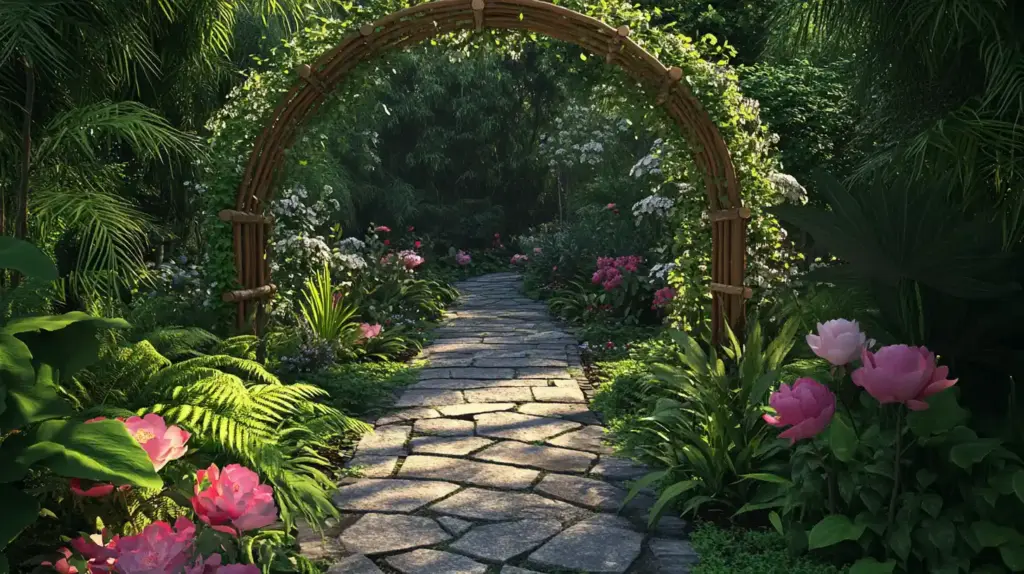
A bamboo arch brings structure and graceful curves to your garden while offering the perfect support for climbing clematis vines. Constructed from flexible yet sturdy bamboo canes, these arches can span walkways, garden entrances, or even stand freely to create a living tunnel of flowers.
Clematis vines thrive when allowed to climb over these arches, producing blooms that cascade overhead and add an enchanting feel to your garden path. Bamboo’s renewable nature makes it an eco-conscious choice, and its golden hue blends effortlessly into lush, green landscapes.
Why it works for clematis:
- Provides ample vertical and horizontal climbing space.
- Encourages blooms to grow overhead for dramatic effect.
- Durable and weather-resistant when properly treated.
Tips:
- Anchor the base of the arch securely into the ground.
- Use garden ties or string to help train vines early on.
- Ideal for lighter, more delicate clematis varieties.
3. Birch Arbor
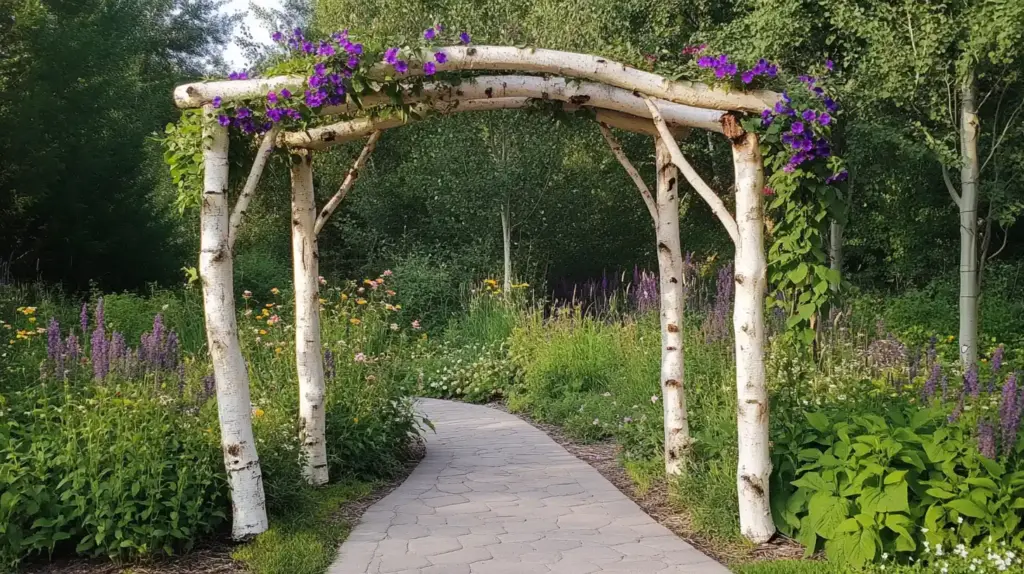
For gardeners who love a woodland aesthetic, a birch arbor offers a naturally rustic backdrop that pairs beautifully with clematis. Made from pale, peeling birch branches, this trellis style brings texture and charm to any garden, creating an inviting vertical accent that feels like it grew right out of the landscape.
Compact clematis varieties look particularly stunning climbing over a birch arbor, where the contrast between soft petals and rugged bark adds visual depth. Whether framing a garden entrance or standing as a centerpiece, a birch arbor can lend an organic, fairytale vibe to your outdoor space.
Why it works for clematis:
- Natural surface texture makes climbing easy for tendrils.
- Birch’s light color contrasts beautifully with vibrant clematis blooms.
- Complements wildflower gardens and forest-edge plantings.
Tips:
- Choose well-aged, dry birch to reduce warping over time.
- Add horizontal supports between uprights for better vine training.
- Best used with lighter clematis types to preserve structural integrity.
4. Corten Steel Obelisk
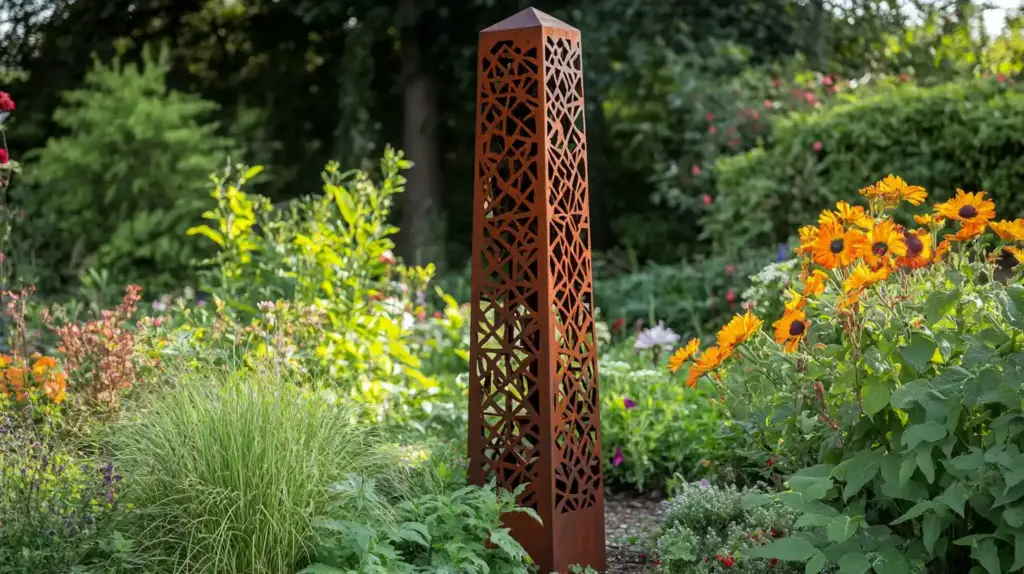
If you’re looking for a trellis that makes a bold statement, the corten steel obelisk is a modern showstopper. With its tall, tapering silhouette and weathered, rust-like finish, this structure adds an industrial edge that contrasts beautifully with the softness of clematis vines.
Corten steel weathers naturally over time, developing a protective patina that resists corrosion while adding character. As clematis climbs the open framework, the vibrant flowers pop against the steel’s rich, earthy tones—creating an eye-catching vertical accent that’s both artistic and functional.
Why it works for clematis:
- Sturdy and long-lasting; great for heavier, vigorous clematis.
- Open design allows vines to weave upward with ease.
- Adds sculptural height and contrast to contemporary gardens.
Tips:
- Place as a centerpiece in gravel beds or minimalist landscapes.
- Combine with climbing roses for a textured, layered effect.
- Ensure good drainage at the base to avoid water pooling.
5. Espaliered Trellis for Small-Space Clematis Trellis Ideas
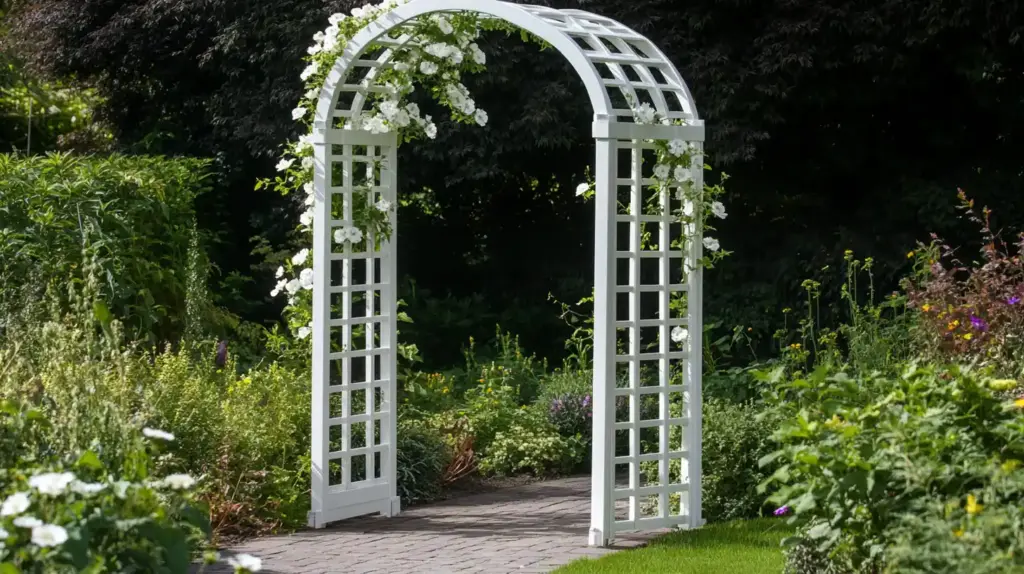
Perfect for small spaces or urban gardens, an espaliered trellis turns vertical surfaces into living art. Originally used in fruit tree training, espaliering involves guiding plants to grow flat along a frame or wall in geometric patterns. With clematis, this technique not only showcases their blooms beautifully but also adds a structured, architectural element to your space.
Mounted against fences, brick walls, or freestanding panels, espaliered trellises allow clematis vines to flourish in areas where space is at a premium. Their orderly, fan-like growth pattern provides visual balance and makes for easy maintenance.
Why it works for clematis:
- Ideal for tight areas like patios, balconies, or narrow beds.
- Keeps plants neat, controlled, and within easy reach.
- Turns bland walls into vibrant focal points.
Tips:
- Use soft garden ties to avoid damaging stems.
- Begin training vines early when stems are flexible.
- Prune regularly to maintain the desired shape.
6. Fan-Shaped Trellis
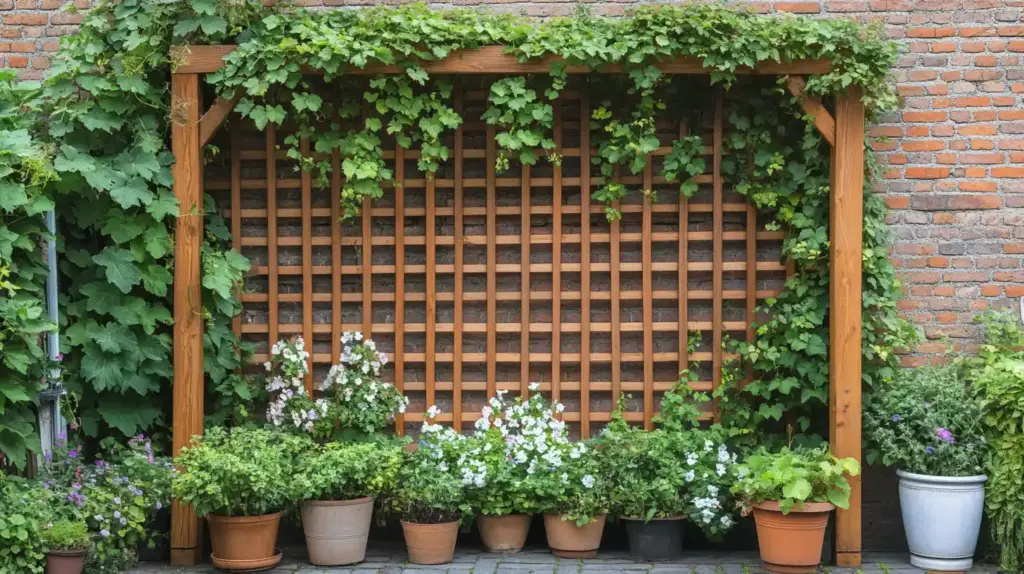
For gardeners who appreciate symmetry and elegance, a fan-shaped trellis offers both visual appeal and structural support. This design features slats that radiate outward like the ribs of a hand-held fan, creating a wide base that narrows toward the top—perfect for guiding clematis vines into a graceful, upward sweep.
Typically crafted from wood or metal, fan-shaped trellises are excellent for showcasing the full bloom display of clematis while keeping the plant tidy and accessible. Whether placed against a wall, fence, or standing on its own, this trellis adds a refined, sculptural element to your garden layout.
Why it works for clematis:
- Wide base supports spreading vines and abundant flowers.
- Radiating structure distributes weight evenly as the plant grows.
- Adds architectural interest to plain vertical spaces.
Tips:
- Mount securely to prevent tipping during windy weather.
- Use as a backdrop for perennial borders or garden benches.
- Paint or stain to match surrounding garden décor for a cohesive look.
7. Freestanding Arch
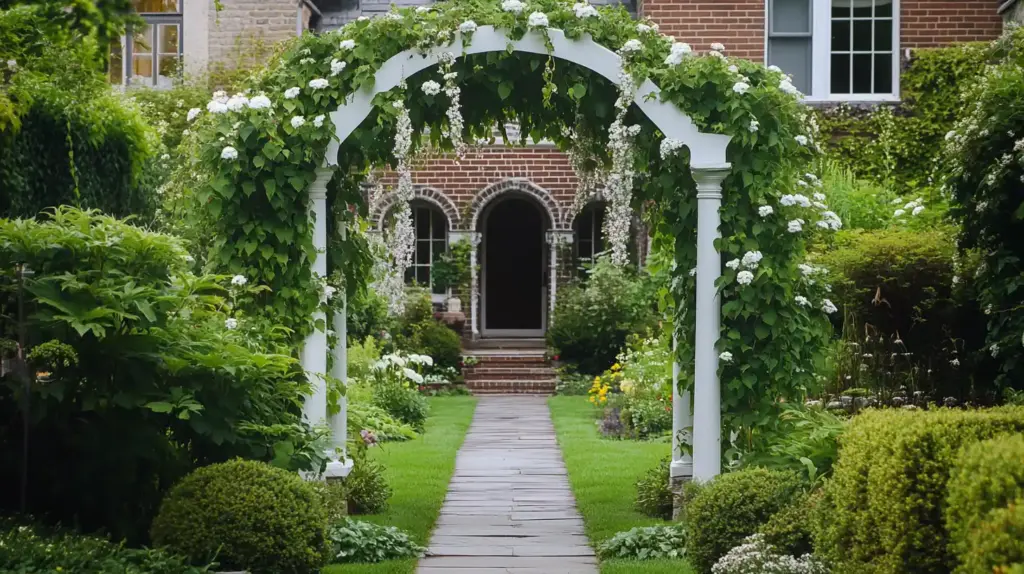
Vertical gardens are excellent clematis trellis ideas for compact urban spaces. Whether mounted on fences or built as freestanding structures, they combine function with flair. Add a vertical garden to your patio or balcony and include climbers, herbs, and even cottage garden flowers for a lush, multi-layered display.
Available in a variety of materials—wood, metal, or vinyl—freestanding arches can match virtually any garden style, from classic English borders to modern minimalist landscapes. As clematis matures, its cascading flowers drape over the arch, forming a living canopy that invites guests to pause and admire.
Why it works for clematis:
- Arched shape allows for multidirectional growth.
- Offers shade and visual drama when fully covered in blooms.
- Makes an excellent focal point or garden entrance.
Tips:
- Anchor legs deeply to ensure stability in wind or rain.
- Plant clematis on both sides for a fuller, more balanced look.
- Match the arch’s scale to your garden path or space dimensions.
8. Gabion Cage
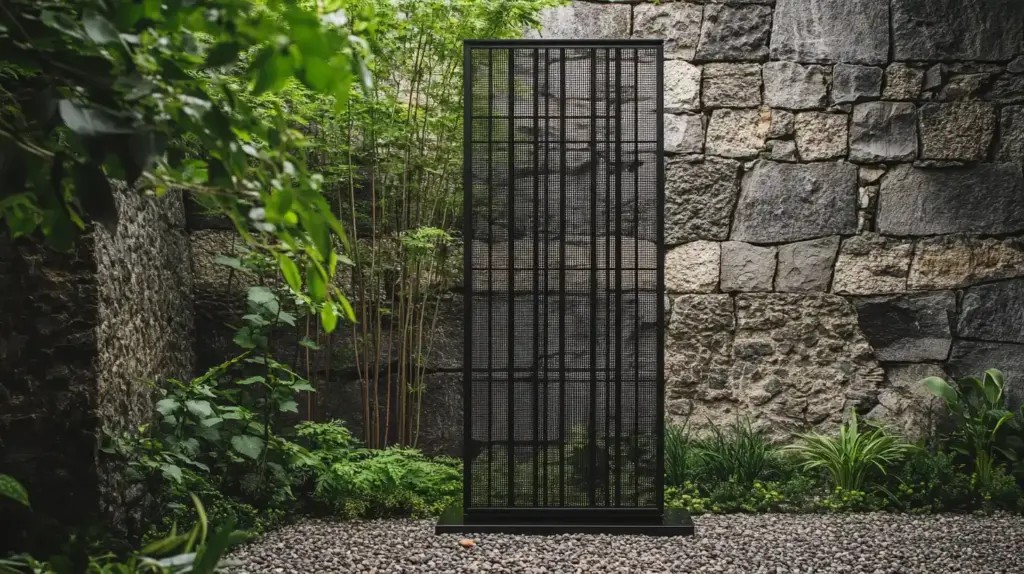
For a trellis that’s as rugged as it is artistic, the gabion cage stands out with its industrial appeal and earthy charm. Constructed from wire mesh filled with stones or gravel, gabion cages offer a sturdy framework that doubles as both garden structure and climbing support.
Clematis vines can easily thread through the mesh, softening the hard edges of the stone with delicate foliage and vibrant flowers. Gabions also serve as retaining walls, garden dividers, or even seating when built wide enough—making them a multifunctional addition to any landscape.
Why it works for clematis:
- Heavy-duty support for vigorous, woody-stemmed varieties.
- Low maintenance—no painting, staining, or weatherproofing required.
- Offers striking contrast between hard stone and soft greenery.
Tips:
- Use light-colored stones to enhance the color of clematis blooms.
- Position near patios or pathways to double as decor or edging.
- Pair with native grasses or succulents for a modern, drought-tolerant look.
9. Hanging Basket
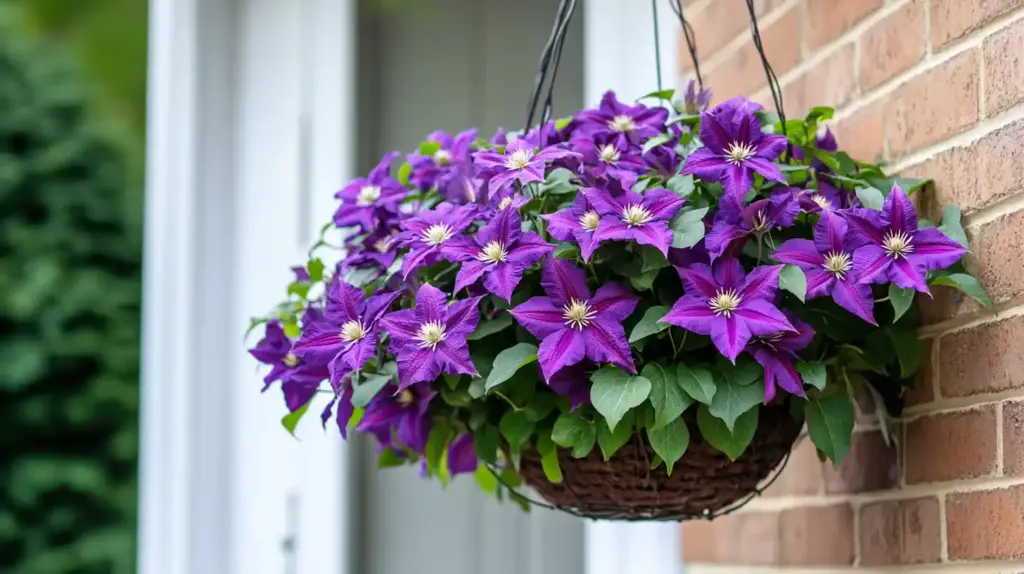
While not a traditional trellis, hanging baskets provide a unique and vertical way to showcase clematis—especially smaller or trailing varieties. When suspended from shepherd’s hooks, pergolas, or balcony railings, these baskets allow clematis vines to spill gracefully over the sides or climb up small central supports placed within the container.
This setup is perfect for gardeners with limited ground space or those looking to add floral accents to patios, porches, or balconies. With the right container and support, a hanging basket becomes both a planter and a living trellis in one.
Why it works for clematis:
- Maximizes vertical space in small areas.
- Brings blooms to eye level or above for dramatic effect.
- Easy to move, reposition, or rotate with the sun.
Tips:
- Use a lightweight potting mix for good drainage and airflow.
- Insert a central mini trellis or ring for upward vine support.
- Choose compact clematis varieties like ‘Bijou’ or ‘Pixie’.
10. Metal Arch Designs in Modern Clematis Trellis Ideas
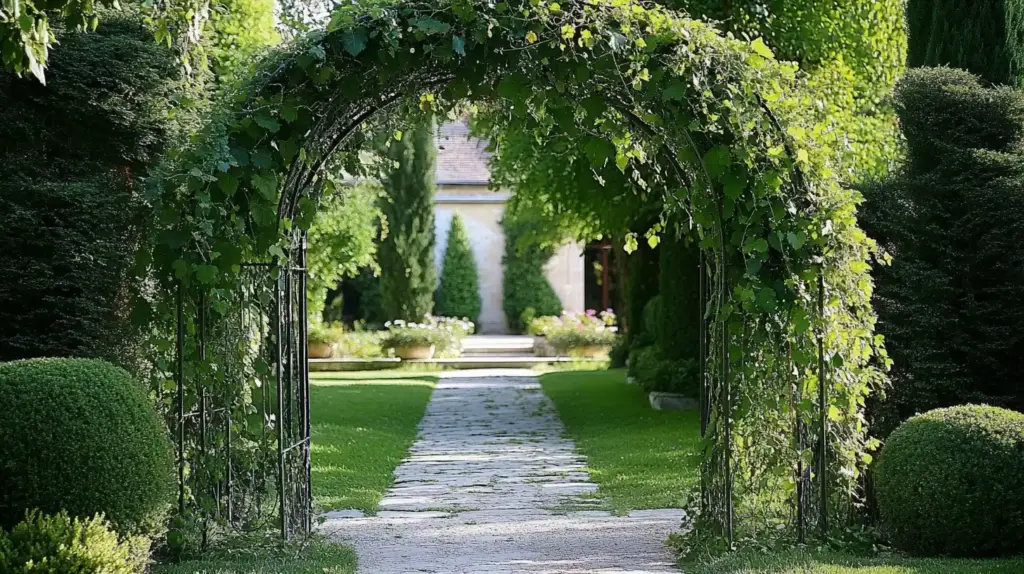
The metal arch stands out as one of the most elegant and long-lasting clematis trellis ideas, combining strength with refined garden style. Whether you lean toward a clean, minimalist design or a more ornate, wrought-iron look, metal arches can be customized to suit any landscape—from contemporary to classic.
Clematis vines thrive on the narrow framework of metal arches, twining naturally and filling the structure with blooms. Among the more architectural clematis trellis ideas, these arches create living portals that bring height, softness, and floral drama to garden paths, courtyards, or entryways.
Why it works for clematis:
- Provides sturdy, long-lasting support for climbing varieties.
- Minimalist structure allows the flowers to be the main focus.
- Resistant to rot, pests, and weather damage.
Tips:
- Powder-coated steel resists rust and prolongs lifespan.
- Use as a pair to frame entrances or walkways.
- Add lighting or hanging lanterns beneath for evening ambiance.
11. Obelisk
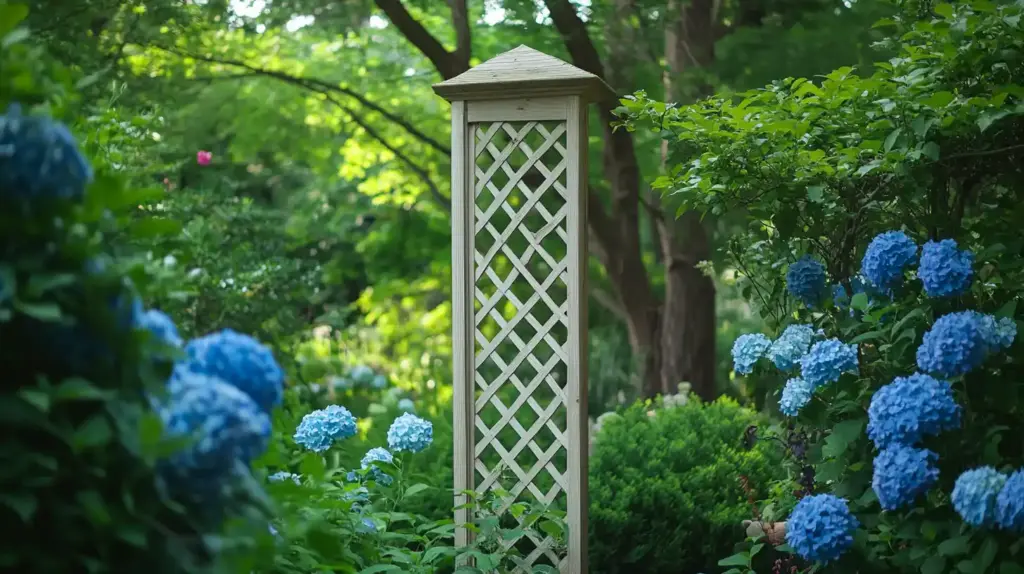
Obelisks are among the most classic and versatile clematis trellis ideas, offering a timeless way to bring height and structure to your garden beds. These tall, tapering trellises—often shaped like pyramids or towers—can be crafted from wood, metal, or decorative resin. When used as garden focal points, they draw the eye upward and make a striking statement, especially when covered in lush clematis blooms.
As compact vertical structures, obelisks are perfect for containers or flower borders. Among practical clematis trellis ideas, they’re excellent for training vines in a tidy, upright shape—ideal for maximizing small spaces while adding ornamental impact.
Why it works for clematis:
- Vertical form promotes airflow and sun exposure.
- Encourages upward growth in compact areas.
- Blends seamlessly into formal or informal garden designs.
Tips:
- Place obelisks before planting to avoid disturbing roots.
- Choose darker colors to contrast with light or pastel clematis.
- Anchor securely to withstand wind and top-heavy growth.
12. Pergola
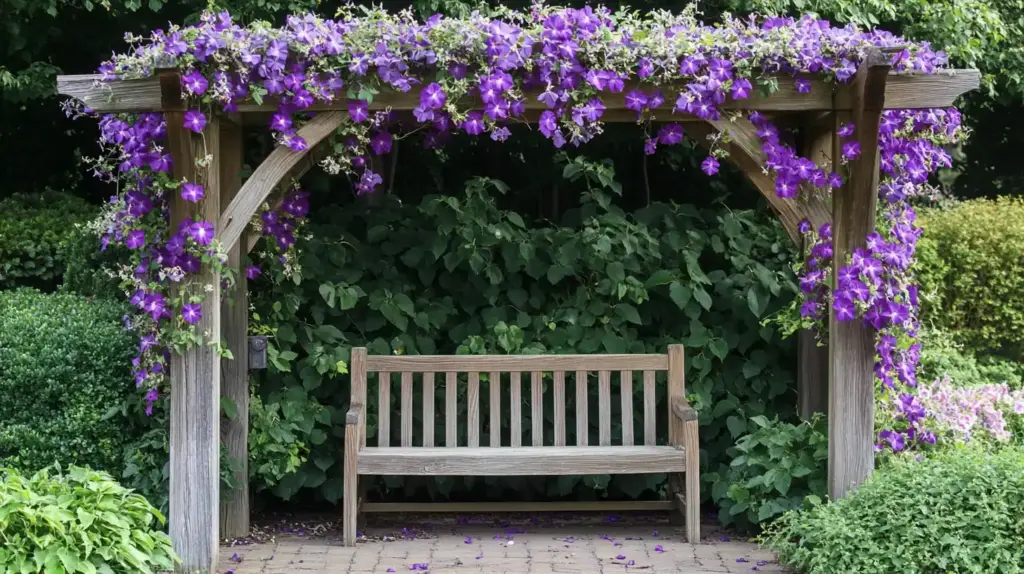
A pergola is more than just a garden structure—it’s one of the most stunning clematis trellis ideas for creating a living room under the sky. With its open roof of crossbeams or latticework, a pergola offers the perfect overhead framework for clematis vines to climb, sprawl, and bloom in cascading layers. As the vines mature, they drape over the structure, filtering sunlight and transforming the area into a serene, shaded retreat.
Among all clematis trellis ideas, pergolas stand out for their ability to define spaces. Whether freestanding or attached to your home, they’re ideal for patios, walkways, or garden seating areas. As clematis grows, it softens the architectural lines, creating a lush floral ceiling that brings color and texture to your outdoor space.
Why it works for clematis:
- Offers abundant space for climbing and spreading.
- Creates cool shade and visual intimacy in open areas.
- Supports multiple vines or a mix of flowering climbers.
Tips:
- Train vines by tying them to upright posts and crossbeams.
- Combine clematis with wisteria or grapevines for a layered look.
- Use treated wood or weather-resistant materials for longevity.
13. Privacy Screen
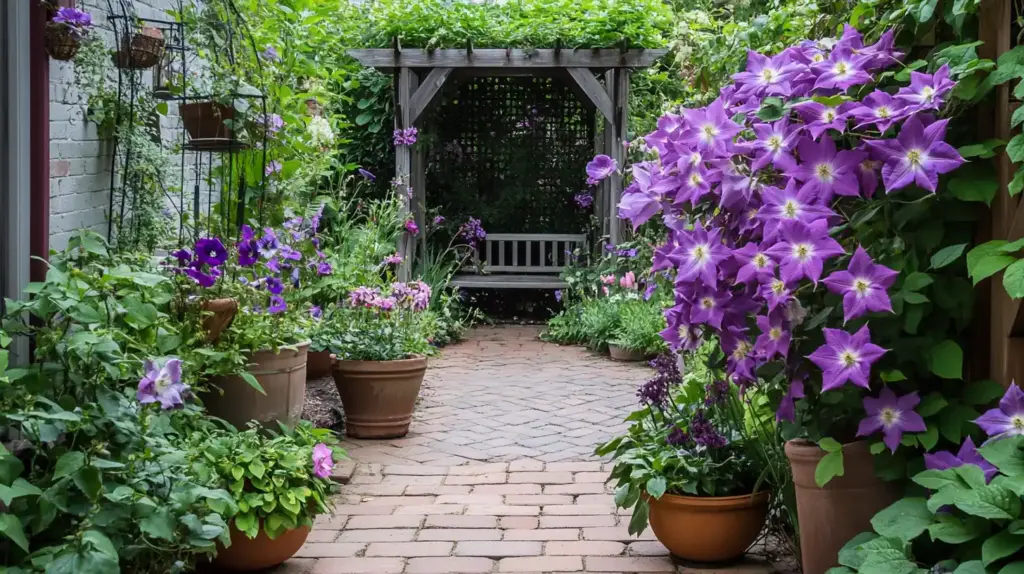
If you’re looking to blend beauty with function, privacy screens are one of the most versatile clematis trellis ideas available. These vertical structures are designed to shield patios, decks, or outdoor living areas from view while offering sturdy support for clematis vines. As the plants climb and mature, they create a living wall that softens hard lines and adds lush greenery with seasonal color.
Among modern clematis trellis ideas, privacy screens come in many styles—wooden panels, lattice fencing, and metal grids—making them easy to integrate into nearly any garden design. When cloaked in clematis blooms, they offer not only privacy but also a vibrant, botanical upgrade to your outdoor sanctuary.
Why it works for clematis:
- Offers both screening and aesthetic enhancement.
- Makes use of vertical space to define garden zones.
- Encourages dense, flower-filled vine coverage.
Tips:
- Choose fast-growing clematis varieties for quicker coverage.
- Install behind seating areas or along property lines.
- Combine with climbing roses or honeysuckle for fragrance and texture.
14. Rustic Reclaimed Wood in Eco-Friendly Clematis Trellis Ideas

Sustainable, rustic, and rich in character, reclaimed wood structures are some of the most charming clematis trellis ideas available. Crafted from salvaged materials like old fencing, barn wood, or shipping pallets, these trellises add a handcrafted touch and weathered charm that beautifully complements the delicate elegance of clematis vines.
Among eco-conscious clematis trellis ideas, reclaimed wood stands out for its texture and storytelling. Each piece brings unique grain, patina, and warmth—turning your trellis into more than just a plant support, but a true piece of garden art. As clematis climbs upward, its vibrant blooms contrast beautifully with the aged wood, creating a rich and natural focal point.
Why it works for clematis:
- Textured surfaces provide excellent grip for tendrils.
- Adds rustic appeal to cottage or natural-style gardens.
- Repurposes materials, reducing waste and saving money.
Tips:
- Sand rough edges to prevent plant or gardener injury.
- Apply a non-toxic sealant to increase wood longevity.
- Integrate with garden borders or raised beds for cohesion.
15. Rope Trellis
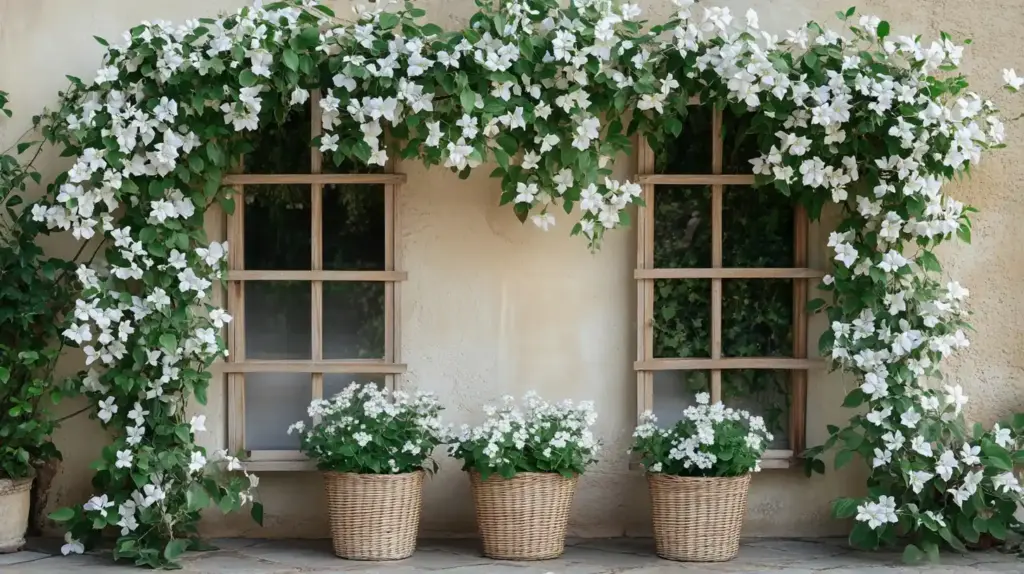
For DIY enthusiasts and fans of natural textures, rope trellises stand out among the most flexible clematis trellis ideas. Made from durable materials like jute, hemp, or sisal, these trellises can be arranged in vertical lines, zigzags, or creative patterns across fences, walls, or open garden frames.
Clematis vines naturally grip the coarse rope surface, making it an ideal material for climbing. As one of the most adaptable clematis trellis ideas, the rope trellis is lightweight, easy to install, and perfect for smaller gardens or urban spaces where smart vertical solutions are key.
Why it works for clematis:
- Soft texture supports tendrils without damaging stems.
- Great for temporary or seasonal installations.
- Offers artistic freedom in design and placement.
Tips:
- Tension the rope tightly to prevent sagging under vine weight.
- Use weather-resistant rope or seal natural fibers for longevity.
- Perfect for creating green “walls” on balconies or patios.
16. Shepherd’s Hook

Though often used for lanterns or bird feeders, shepherd’s hooks are also a clever choice in minimalist clematis trellis ideas—especially for containers or small garden beds. Their curved tops give clematis vines a natural starting point for upward growth, while their lightweight, portable design makes them ideal for flexible garden arrangements.
As one of the more subtle clematis trellis ideas, these powder-coated metal hooks come in various heights and styles. For compact clematis varieties, they offer just enough vertical support without overwhelming the space, making them a simple yet effective addition to any garden.
Why it works for clematis:
- Lightweight and easy to move as needed.
- Ideal for potted clematis or accent planting in beds.
- Blends easily into different garden aesthetics.
Tips:
- Anchor deeply in the soil to ensure stability.
- Choose double or twin-hook styles for extra support or added decor.
- Pair with hanging baskets or wind chimes for extra charm.
17. Tuteur
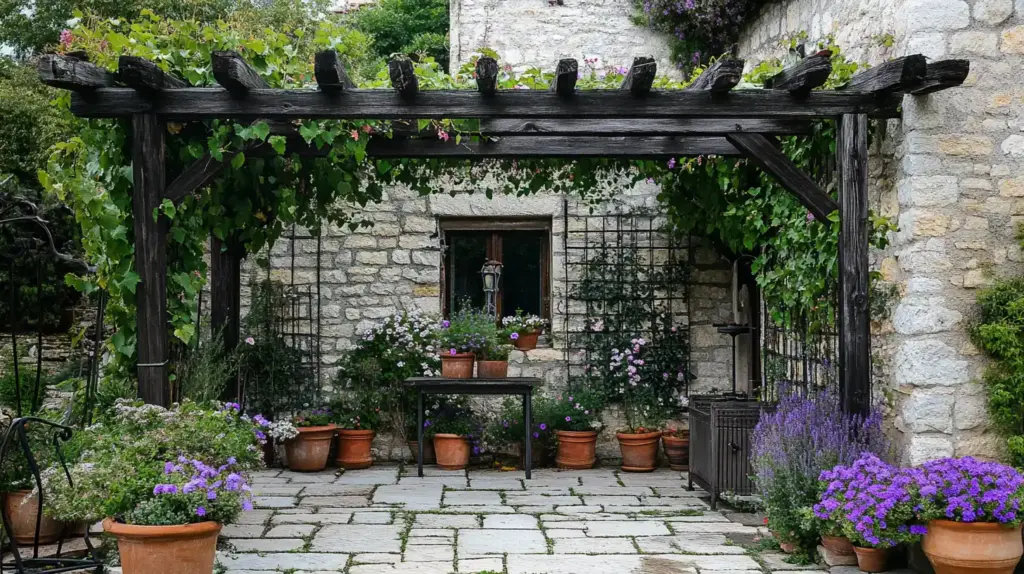
Inspired by classic French garden design, the tuteur (pronounced too-TUR) is a standout option among elegant clematis trellis ideas. This pyramidal structure adds a sculptural, formal touch to your garden and offers sturdy vertical support for climbing vines. Typically built with four or more vertical supports connected by rings or crossbars, a tuteur provides a reliable framework for clematis to thrive.
Tuteurs are excellent for anchoring flower beds, raised planters, or even large containers. As the clematis climbs and wraps around the frame, this trellis style becomes a dramatic, bloom-covered spire—one of the most eye-catching clematis trellis ideas for adding vertical dimension to your landscape.
Why it works for clematis:
- Provides excellent vertical support and plant training structure.
- Adds symmetry and elegance to formal or edible gardens.
- Works well in both open beds and confined spaces.
Tips:
- Secure the base well to avoid tipping in windy conditions.
- Paint or stain to match garden decor or make it a standout focal point.
- Use in sets of two or three for visual balance in large spaces.
18. Vertical Garden
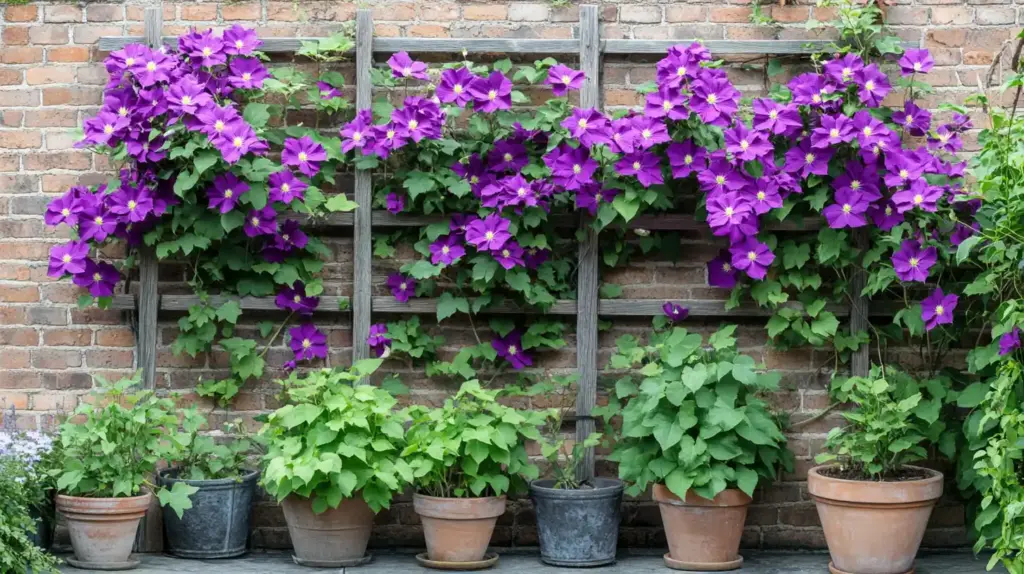
A vertical garden is one of the most versatile clematis trellis ideas for gardeners working with limited horizontal space. These wall-mounted or freestanding setups often combine plant pockets, shelves, and trellis panels—making them perfect for showcasing clematis alongside herbs, succulents, or ferns. When clematis vines are trained through the vertical frame, they bring vibrant color and movement to walls or fences that would otherwise remain flat and uninviting.
From upcycled wooden pallets to modern modular planters, vertical gardens offer endless design possibilities. As one of the more creative clematis trellis ideas, this setup turns any patio, balcony, or urban backyard into a blooming, space-savvy retreat.
Why it works for clematis:
- Maximizes growth in narrow or paved areas.
- Enhances vertical surfaces with color and texture.
- Combines form and function—gardening meets design.
Tips:
- Ensure the structure is strong enough to support mature vines.
- Incorporate drip irrigation or self-watering systems for easy care.
- Combine with herbs or low-maintenance plants for a mixed display.
19. Wall-Mounted Trellis
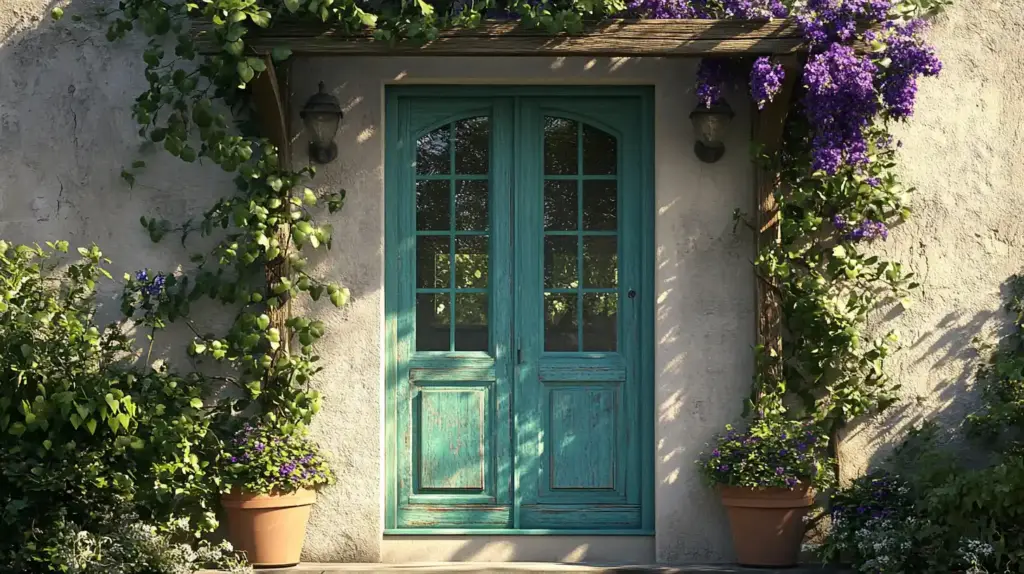
A wall-mounted trellis is one of the most space-efficient clematis trellis ideas, perfect for adding vertical beauty in small gardens, courtyards, or balconies. Mounted directly onto fences, brick facades, or exterior walls, these structures offer sturdy support for clematis vines while also serving as decorative elements that enhance your garden’s architecture.
Among the more practical and minimalist clematis trellis ideas, wall-mounted designs come in materials like wrought iron, wood slats, or metal grids. As your clematis climbs and blooms, the trellis transforms any blank wall into a vibrant, living tapestry of color and movement.
Why it works for clematis:
- Ideal for maximizing space in compact areas.
- Encourages upward growth and bloom visibility.
- Turns plain walls into garden focal points.
Tips:
- Allow a small gap between the wall and trellis for air circulation.
- Use anchors or brackets to ensure secure mounting.
- Choose fast-growing clematis varieties for quick coverage.
20. Wrought Iron Arch – Classic Elegance in Clematis Trellis Ideas

If you’re aiming for classic garden elegance, wrought iron arches are one of the most timeless clematis trellis ideas to consider. With their sturdy build and intricate scrollwork, these trellises provide reliable support for clematis vines while elevating your garden’s overall design. The arch shape encourages the vines to form a sweeping canopy, and the detailed ironwork adds year-round visual interest—even when blooms are out of season.
As one of the more decorative clematis trellis ideas, wrought iron arches also make stunning entrances or garden focal points. When covered in flowers, they transform into breathtaking floral frames that bring structure, color, and charm to any outdoor setting.
Why it works for clematis:
- Strong enough to support vigorous, mature vines.
- Beautiful year-round, even when not in bloom.
- Offers long-term durability with minimal maintenance.
Tips:
- Anchor deeply or use cement footings for stability.
- Choose weather-resistant coatings to prevent rusting.
- Combine with climbing roses or jasmine for a romantic effect.
Frequently Asked Questions (FAQ)
1. What type of trellis is best for clematis?
The best trellis for clematis depends on your garden style, space, and overall design goals. Popular clematis trellis ideas include freestanding obelisks, pergolas, and wall-mounted structures—all offering strong support and visual appeal. Look for designs with narrow slats or textured surfaces that clematis tendrils can grip easily for healthy, upward growth.
2. Can clematis grow in pots with a trellis?
Yes! Clematis can thrive in containers when given proper drainage, nutrient-rich soil, and a supportive structure. Many clematis trellis ideas for small spaces include using compact supports like mini obelisks, tuteurs, or shepherd’s hooks—perfect for container gardening. Compact clematis varieties are especially well-suited for pots and smaller patios.
3. How do I train clematis to climb a trellis?
As part of many practical clematis trellis ideas, gently tie new growth to the structure using soft garden ties or twine. Since clematis vines don’t wrap around poles on their own, they need a bit of early guidance. Once established, they’ll latch onto textured supports with their leaf stems and climb beautifully on their own.
4. Does clematis need full sun to bloom well?
Most clematis varieties prefer full sun—at least 6 hours a day—while keeping their roots cool and shaded. Many successful clematis trellis ideas recommend using mulch or planting low-growing companions at the base to protect the roots while the vine stretches upward toward the light.
5. What’s the best time to install a clematis trellis?
Install your chosen trellis before planting or while the clematis is still young—this is a smart tip often emphasized in clematis trellis ideas guides. Early installation helps avoid root damage and makes it easier to train the vine, ensuring your structure stays secure as the plant becomes fuller and more top-heavy.
Conclusion
Clematis vines bring vertical beauty and vibrant color to any garden—but the real magic happens when they’re supported by the right structure. With so many clematis trellis ideas to choose from—rustic bamboo, industrial steel, romantic wrought iron—there’s a perfect match for every garden style and setting.
By exploring creative and practical clematis trellis ideas, you not only support healthy vine growth but also add privacy, structure, and year-round charm to your outdoor space. For even more inspiration on how to transform your yard with climbing plants, check out these stunning rose garden trellis layouts that showcase vertical beauty at its finest. Let your clematis climb high and your imagination go even higher, as you build a garden that’s as functional as it is beautiful.




